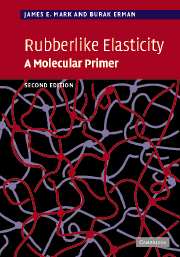Book contents
- Frontmatter
- Contents
- Preface to the first edition
- Preface to the second edition
- Part I Fundamentals
- Part II Additional topics
- 11 Networks prepared under unusual conditions
- 12 Strain-induced crystallization and ultimate properties
- 13 Multimodal networks
- 14 Birefringence and segmental orientation
- 15 Neutron scattering from networks
- 16 Liquid-crystalline elastomers
- 17 Bioelastomers
- 18 Filled elastomers
- 19 Current problems and new directions
- Appendix A Relationships between ν, ξ and Mc
- Appendix B Relationships between 〈r2〉, 〈(Δr)2〉, 〈r2〉0, and ϕ
- Appendix C Equations of state for miscellaneous deformations from the constrained junction theory
- Appendix D Thermodynamics of the relationship of stress to temperature
- Problems
- Answers to problems
- Some publications describing laboratory/classroom experiments or demonstrations
- References
- Index
15 - Neutron scattering from networks
from Part II - Additional topics
Published online by Cambridge University Press: 04 December 2009
- Frontmatter
- Contents
- Preface to the first edition
- Preface to the second edition
- Part I Fundamentals
- Part II Additional topics
- 11 Networks prepared under unusual conditions
- 12 Strain-induced crystallization and ultimate properties
- 13 Multimodal networks
- 14 Birefringence and segmental orientation
- 15 Neutron scattering from networks
- 16 Liquid-crystalline elastomers
- 17 Bioelastomers
- 18 Filled elastomers
- 19 Current problems and new directions
- Appendix A Relationships between ν, ξ and Mc
- Appendix B Relationships between 〈r2〉, 〈(Δr)2〉, 〈r2〉0, and ϕ
- Appendix C Equations of state for miscellaneous deformations from the constrained junction theory
- Appendix D Thermodynamics of the relationship of stress to temperature
- Problems
- Answers to problems
- Some publications describing laboratory/classroom experiments or demonstrations
- References
- Index
Summary
Introduction
One of the first relevant applications of neutron scattering measurements confirmed that chains in the bulk, undeformed amorphous state exhibit their unperturbed dimensions (Flory, 1984), as we mentioned in Chapter 1. Of much greater current interest, however, are measurements on deformed networks, which we describe here. Establishing the proper relationship between an externally applied state of deformation and the corresponding changes at the molecular level is essentially the most important problem in the molecular theory of rubber elasticity. The phantom and the affine network models make different assumptions for this necessary relationship between the macroscopic and the microscopic states of deformation. An experimental test of these relations is possible by the small-angle neutron scattering (SANS) technique. According to this technique, the shape and size of network chains in the undeformed and deformed states can be measured directly. The basic principle rests on labeling certain sites, such as the junctions or points along the chains, by replacing hydrogen atoms with deuterium and then measuring the intensity of scattering from the labeled molecules. In this way, scattering from individual molecules may be measured, whereas in the more conventional light and X-ray scattering techniques, contributions from a group of neighboring molecules cannot be separated.
SANS studies of networks were initiated by Benoit and collaborators (Munch et al., 1976) and have generated wide interest in subsequent years (Hinckley et al., 1978; Clough et al., 1980; Beltzung et al., 1982; Bastide et al., 1984).
Information
- Type
- Chapter
- Information
- Rubberlike ElasticityA Molecular Primer, pp. 159 - 164Publisher: Cambridge University PressPrint publication year: 2007
